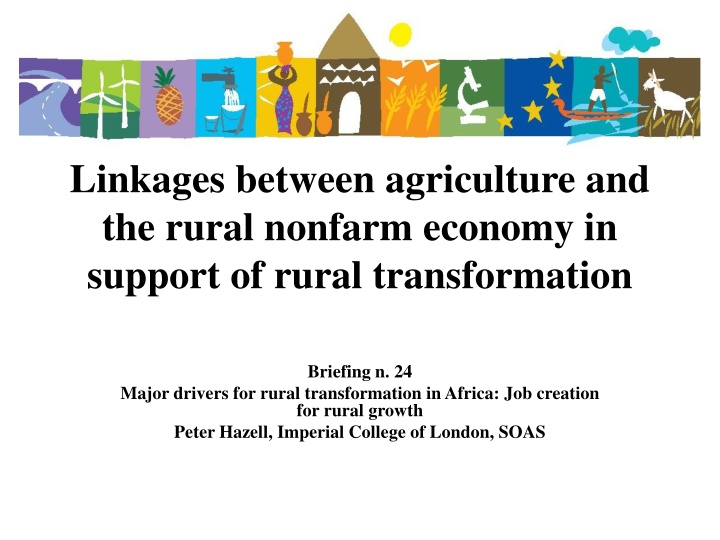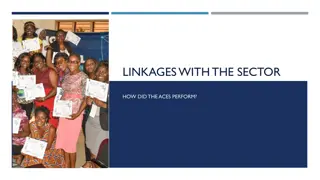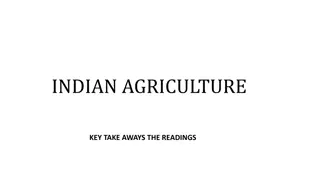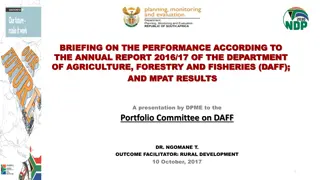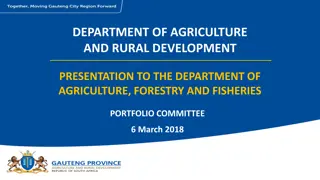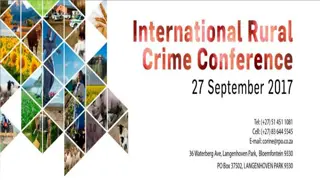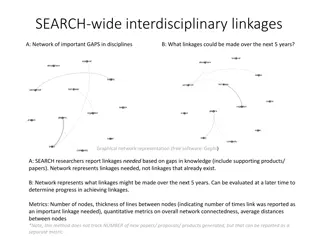Linkages Between Agriculture and Rural Nonfarm Economy for Rural Transformation in Africa
Agriculture plays a key role in driving rural economic growth in developing regions, with strong linkages to the rural nonfarm economy (RNFE). As agriculture prospers, so does the RNFE. However, over time, the dependence on agriculture decreases as countries urbanize and diversify. Recent trends in Asian countries show rapid rural nonfarm growth independent of agriculture in well-connected regions. Globalization and market liberalization have further impacted the RNFE, offering new avenues for rural economic development and poverty reduction. The potential of these new opportunities to substitute for agricultural growth as the primary driver of the RNFE is a topic of emerging empirical research.
Download Presentation

Please find below an Image/Link to download the presentation.
The content on the website is provided AS IS for your information and personal use only. It may not be sold, licensed, or shared on other websites without obtaining consent from the author.If you encounter any issues during the download, it is possible that the publisher has removed the file from their server.
You are allowed to download the files provided on this website for personal or commercial use, subject to the condition that they are used lawfully. All files are the property of their respective owners.
The content on the website is provided AS IS for your information and personal use only. It may not be sold, licensed, or shared on other websites without obtaining consent from the author.
E N D
Presentation Transcript
Linkages between agriculture and the rural nonfarm economy in support of rural transformation Briefing n. 24 Major drivers for rural transformation in Africa: Job creation for rural growth Peter Hazell, Imperial College of London, SOAS
Agricultural growth linkages Agriculture has historically played an important role in expanding the economic base of rural regions in the developing world. In regions where agriculture has grown robustly, the rural nonfarm economy (RNFE) has also typically enjoyed rapid growth. Studies show that each dollar of additional income in agriculture generates $0.6 to $0.8 of additional RNFE income in Asia, and $0.3 to $0.5 in Africa and Latin America. Regions with poor agricultural potential have seen more limited prospects for rural nonfarm growth, except in places where activities like mining, logging, tourism and entrep t trade have offered an alternative economic platform for sustaining regional growth.
Dynamics of Change Although the prosperity of rural regions typically depends on agricultural performance during the early stages of economic development, this link gradually weakens over time as agriculture s share in national economies declines. As countries successfully transform, they urbanize, diversify their economies, and build up their infrastructure, and this opens up new market opportunities for rural nonfarm producers and rural workers. Rural regions that are well connected to urban centres tend to gain the most from these new opportunities, but even lagging regions eventually benefit.
These dynamic patterns of RNFE development are reasonably well understood, but they have recently been illustrated rather dramatically in some Asian countries that have sustained high rates of national economic growth over the past decade or so. Evidence from India, for example, suggests that rapid rural nonfarm growth is occurring along transport corridors linked to major urban centers, largely independent of their agricultural base. Similarly, in Southeast Asia and in China high population density and low transport costs have led to rapid growth in urban-to-rural subcontracting for labor-intensive manufactures destined for international export markets, and to astonishing rates of rural-urban migration.
Liberalization and Globalization What is new and less well understood is the impact of globalization and market liberalization on the RNFE. Beginning in the 1990s, these forces have opened up new opportunities in many rural areas, reducing their dependence on agriculture, even in countries that have not experienced rapid national economic growth. Some see these developments as offering new prospects for stimulating rural economic growth and, perhaps, new pathways out of poverty. But just how powerful are these new opportunities and to what extent can they substitute for agricultural growth as the main driver of the RNFE in the early stages of development? Although empirical evidence has begun to trickle in, these processes are still unfolding in many settings. Firm conclusions will require more time and new field studies.
By reducing direct government involvement in production and marketing, liberalization has opened up new market opportunities for the private sector, particularly in agricultural processing, input supply and trade. Relaxed controls on foreign exchange and investment have unleashed a flood of foreign direct investment into Latin America, Asia and Africa. As a result, large exporters, agribusiness firms and supermarket chains increasingly penetrate rural economies of the developing world, altering the scale and structure of rural supply chains as they do.
Although liberalization has opened up opportunities for some rural suppliers to access new markets, it has also exposed other rural businesses to new threats. Some categories of rural nonfarm activity have thrived in the past because of protection from outside competition by high transport costs, restrictive production policies (such as reserved handicraft industries in India) and trade policies (including barriers to cheap imported consumer goods), subsidized inputs and credit, and preferential access to key markets. Globalization and market liberalization removed many of these barriers, effectively deprotecting the RNFE. The transition may prove brutally abrupt for many traditional small-scale manufacturing activities whose products cannot compete with higher quality, mass-produced goods. For this reason, the initial stages of deprotection can lead to significant job losses in the RNFE, even though many of these may later be recovered as new types of rural nonfarm activity sprout up, as in India during the 1990s.
The entry of large corporate players also imposes new ways of doing business that risk excluding undercapitalized rural enterprises on which the rural poor often rely. In Latin America, where supermarkets now account for over 60% of food retailing, the risks of this increasing market concentration have been most pronounced. Available evidence suggests that rapid concentration has triggered the bankruptcy of thousands of small firms in recent decades. Even in sub-Saharan Africa, South African supermarket chains have expanded aggressively northward in recent years. Two major chains, Shoprite and Pick N Pay, have opened outlets in cities and rural towns in Zambia, Malawi, Mozambique and Uganda. In each locality, their entry has altered product selection and market share in favour of imported South African brands at the expense of local farmers, processors, food suppliers and retailers.
Implications Based on the fragmentary evidence available to date, it appears that the new forces of globalization and liberalization are proving most powerful in densely populated, rapidly growing countries like India and China. That is, they are proving more powerful in countries that are already experiencing rapid national economic growth, and whose rural economies are already being transformed. Opportunities for urban-led rural growth appear more limited in poorer, less densely populated and more slowly growing economics, such as much of Africa. Controlling for national context, regions with better infrastructure and market access seem more likely to benefit from urbanization and globalization, and these are often the better off regions to begin with. As a result, rural areas with good infrastructure and market access and which are located in successfully growing countries appear likely to gain most from urbanization and globalization, while remote backward regions in poor, slow growing countries will gain the least.
Recommended reading Haggblade, Steven, Peter Hazell and Thomas Reardon (eds.). Transforming the Rural Nonfarm Economy. Baltimore: Johns Hopkins University Press, 2007. Haggblade, Steven, Peter Hazell and Thomas Reardon. The Rural Nonfarm Economy: Prospects for Growth and Poverty Reduction . World Development, 38(10):1429-1441, 2010.
